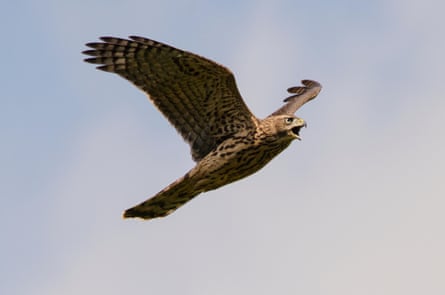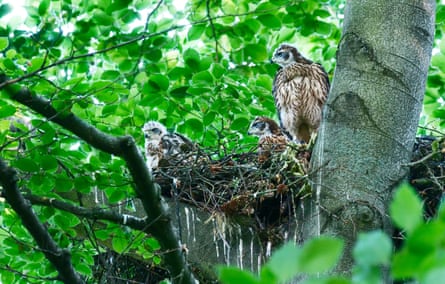‘It proves this can be done’: Berlin the blueprint to bring goshawks to UK cities
October 3, 2025
Firing off rapid keck-keck-keck cries that rang out through a park in central Berlin, the goshawks soared high above the trees and circled before swooping down to chase off a ragtag bunch of crows that had begun to mob them from below.
“It’s basically a flying Batman bringing law and order to the city,” said the conservationist Dr Paul O’Donoghue, peering through binoculars at two breeding pairs of the large pale-bellied birds as they dipped and dived through the sky. “They’re like stealth bombers.”
The goshawk is an apex predator – and, if O’Donoghue has his way, it will soon be bringing awe and delight to British cities as well as German ones. In the UK the fast-moving raptor, which was hunted to virtual extinction and only began to recover in rural regions in the 1960s, is still widely persecuted on shooting estates and grouse moors.
In other parts of Europe, the goshawk is thriving – even in bustling capitals such as Berlin, Amsterdam and Prague. From Berlin’s Viktoriapark, where a large nest sat in the crown of a tree less than 100 metres from a large war memorial, the “phantom of the forest” hunts pigeons in the street and even perches on rooftops.
The birds have adapted to the busy traffic – although tall glass buildings still pose a threat – and are far more at ease with the steady stream of dogwalkers, runners and schoolchildren than their forest-dwelling counterparts would be with humans.

“This is just like any park in the UK, that’s the magical thing,” said O’Donoghue, the director of Rewilding UK, which plans to bring goshawks to Chester and London in the first stage of a project introducing them to cities. “It proves this can be done quickly – without much fuss, but with so much excitement.”
O’Donoghue is planning to submit a proposal for the “assisted colonisation” of the northern goshawk to regulator Natural England in the coming weeks; the plan foresees the release of 15 birds in each of the two cities, sourced as chicks from wild European nests and UK breeders.
He hopes they will come to the rescue of Britain’s beleaguered garden birds by preying on mesopredators such as crows, magpies and jackdaws, whose populations have grown unchecked and threatened birds further down the food chain.

Their presence should have an immediate effect on the “brazen” mid-sized birds that peck off smaller ones that people love, says O’Donoghue, pointing to a similar effect documented in wolves. “It’s what’s called an ecology of fear. Everybody knows the big guys are in town.”
Rewilding efforts across Europe have faced fierce resistance from farmers and far-right groups in recent years, as big carnivores such as wolves and bears have returned to lands now populated by people. As their populations have grown, they have begun to eat sheep and in some cases attack humans.
The introduction of the goshawk into urban England is unlikely to spark a similar backlash – the birds already live in other parts of the country, and pet-owners and urban gardeners have little to fear from them – but the species has caused tensions even in cities it has long called home.
In Berlin, where an estimated 100 breeding pairs represent the highest-known concentration in the world, and other German cities, goshawks have become the focus of pigeon and chicken breeders whose birds are being eaten.
Manuela Merling de Chapa, a scientist at the Hessian Agency for Nature Conservation, Environment and Geology, who has studied goshawk adaptation to urban environments, used GPS transmitters to track 60 goshawks as part of her PhD, and says that although there could be potential benefits from using goshawks to regulate mesopredators in UK cities, chicks taken from rural nests may struggle to adjust to urban life and stressed the need to include all stakeholders early on. “Overall, it’s a risky business.”
Ian Henderson, an ecologist at the British Trust for Ornithology, who has studied goshawk behaviour in rural England, said it was unclear if the birds would choose to stay in cities and unlikely that the proposed numbers would be enough to have a significant positive effect on garden bird populations. “What will happen to those 15 birds?” he said. “My guess is they’ll probably disperse into the nearest countryside.”
O’Donoghue is nonetheless upbeat about the project’s chances. The conservationist, who has previously been awarded a licence to tag the Scottish wildcat and was a scientific adviser for a project that brought the great bustard back to the UK, argues that approaching reintroductions in a “welfare-based manner” is the key to success.

O’Donoghue’s first attempt to reintroduce lynx to the UK was refused by the environment secretary on Natural England’s advice in 2018. A draft application for a trial reintroduction has also met resistance, although the chair of the nature body recently expressed enthusiasm about the prospect of reintroducing lynx during his two-year term.
If the goshawk project goes ahead, the birds will be fitted with GPS transmitters – an endeavour expected to account for almost half of the estimated project cost of £110,000 – and be given a steady supply of food for as long as is needed after being released. In Berlin, O’Donoghue stressed the psychological benefit of city-dwellers being able to spot a predator as elusive as the goshawk while they go about their lives, rather than placing rewilding projects only in rural areas.
“It’ll inject such excitement,” he said. “People go to the park to feed pigeons. Soon they’ll be going to see goshawks.”
Search
RECENT PRESS RELEASES
Related Post


